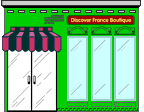Are the Painting in Radio City Music Hall Art Deco or Art Neauvue
| | | . |

| DiscoverFrance.net! |
| |

| |
| |
| TRAVEL Middle | |
| Airline Tickets | |
| Car Rentals | |
| Currency | |
| Hotels, Condos | |
| Medical | |
| Rail Passes | |
| | |
| by Agum Network | |

Click to a higher place to
search this site
or the Net.

to visit our
Boutique!
![]()
Click to a higher place for
optional background
music while you lot browse!
![]()
Click above to run across
random quotations!
![]()

PLEASE VISIT OUR ART Boutique TO VIEW PRINTS Past FRENCH ARTISTS
A rt Deco is an architectural and decorative-arts style, popular from 1910 to 1940, that is characterized by highly stylized natural and geometric forms and ornaments, usually strongly symmetrical. Outstanding American examples of Art Deco are the Chrysler Building and Radio Urban center Music Hall in New York City. Some of the century's virtually pregnant artists, such as Pablo Picasso, Fernand Leger, Sonia Delaunay, and Wassily Kandinsky, produced work in the way, equally did designers of furnishings, textiles, jewelry, and advertising.
A rt Deco themes were oft classical motifs reduced to geometric stylizations. Edgar Brandt decorated wrought-atomic number 26 screens with symmetrical fountains; Emil Ruhlman inlaid ebony cabinets with ivory to depict floral arrangements of geometrical precision; René Lalique etched scenes, such as a gracefully striding female with a wolfhound or a gazelle, into crystal or frosted glass; and Jean Puiforcat and Daum depicted abstract geometric forms.
T he term Fine art Deco, coined in the 1960s when interest in the style revived, was derived from L'Exposition Internationale des Arts Décoratifs et Industriels Modernes. This Paris exhibition of 1925 came midway in Art Deco'southward development and was a definitive display of the manner. At this time Art Deco was besides known as "Art Moderne" or "Modernistic"; later it was called "Jazz Pattern," or "Skyscraper Modern."
T he International Fashion in compages developed at the same time, and afterwards 1925 it considerably influenced the final phase of Fine art Deco. Along with cubist painting and the German Bauhaus school, the work of Le Corbusier and other International Style architects effected a change from the earlier, more decorative phase of Fine art Deco toward a simpler, bolder approach typical of the 1930s.
A rt Deco emerged as a reaction to Fine art Nouveau. Its 2 forerunners were Charles Rennie Mackintosh of Scotland and Josef Hoffmann of Vienna. These men were reformers of the excesses of the Art Nouveau style, and their works in 1900 were an indication of what was to announced in the adjacent decades.
H offman's austere Palais Stoclet in Brussels (1905-xi), with its mosaic murals by Gustave Klimt, was surprisingly advanced for its fourth dimension, and it marked the transition from Art Nouveau to Art Deco. In 1903 Hoffman founded the Wiener Werkstatte, a workshop that produced some of the earliest Fine art Deco designs.
T hese concepts were introduced in Paris in 1910 with an exhibition of decorative arts from Munich and Vienna at the Louvre. On display was a new mode based on a simplification of the early 19th-century neoclassical Biedermeier style and of peasant art, or folk art, quite the antithesis of Art Nouveau. Another significant consequence in Paris in 1910 was the presentation by the Ballets Russes de Serge Diaghilev of Scheherazade. Leon Bakst had concocted oriental sets and costumes in dazzling, barbaric colors; this brought a need in the fashion world for exoticism, soon answered by the couturier Paul Poiret. In 1912, Poiret created his own design schoolhouse, the Atelier Martine, to farther his Fine art Deco ideas. By the 1920s the effects of cubist painting were seen in advertising and product designs. Coco Chanel used cubist colors and forms in creating women'southward fashions, which she adorned with Art Deco jewelry.
A frican sculpture and ancient Egyptian and Southwest American Indian arts all had their influence on Art Deco in this decade, as did Archaic Greek fine art. With the influence of the Bauhaus and the International Style subsequently 1925, Art Deco arrived at a terminal development that reflected the industrial age, thus achieving a reconciliation of the arts and machine production that had troubled artists and designers since the Industrial Revolution began.
Eastward. M. Plunkettm, Art Historian.
Source: The Grolier Multimedia Encyclopedia, Release #9.01, ©1997.
Bibliography: Victor Arwas, Art Deco (1985), Art Deco Sculpture (1985), and Glass: Art Nouveau to Art Deco (1987); Martin Battersby, Fine art Deco Mode (1974; repr. 1984); Alistair Duncan, American Fine art Deco (1986) and, as ed., The Encyclopedia of Art Deco: An Illustrated Guide to a Decorative Manner from 1920 to 1939 (1988); Bevis Hillier, The World of Art Deo (1971; repr. 1981); Alain Lesieutre, The Spirit and Splendour of Art Deco (1974); Edward Lucie-Smith, Art Deco Painting (1990); Theodore Menten, The Art Deco Mode (1972).
Images: "xxx"
Copyrights Notice and Disclaimer: Images of artists' works displayed throughout this site have been obtained from numerous sources, including digital libraries at educational institutions, educational software, and Mark Harden's Artchive. Credit is attributed when known. Some works are considered to exist in the public domain, based on electric current U.S. and international copyright acts. For more information on copyright laws, please refer to the Artists Rights Society and Benedict O'Mahoney's The Copyright Spider web Site. [See also: DiscoverFrance.internet Copyrights.]
| Fine art Deco Links: | |
|
| | |
| | |
Source: https://www.discoverfrance.net/France/Art/deco.shtml


0 Response to "Are the Painting in Radio City Music Hall Art Deco or Art Neauvue"
Post a Comment